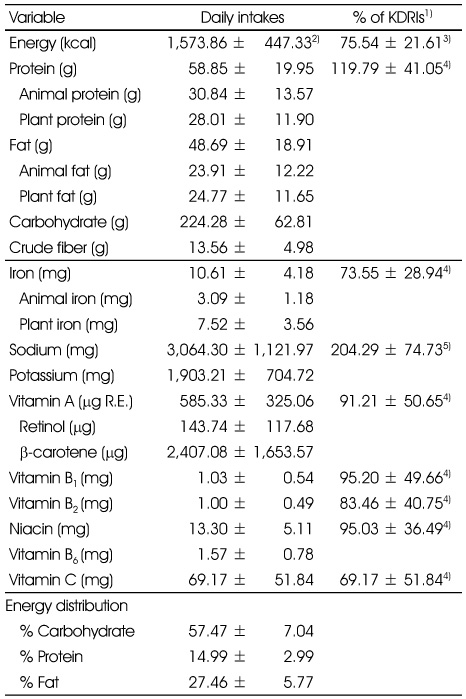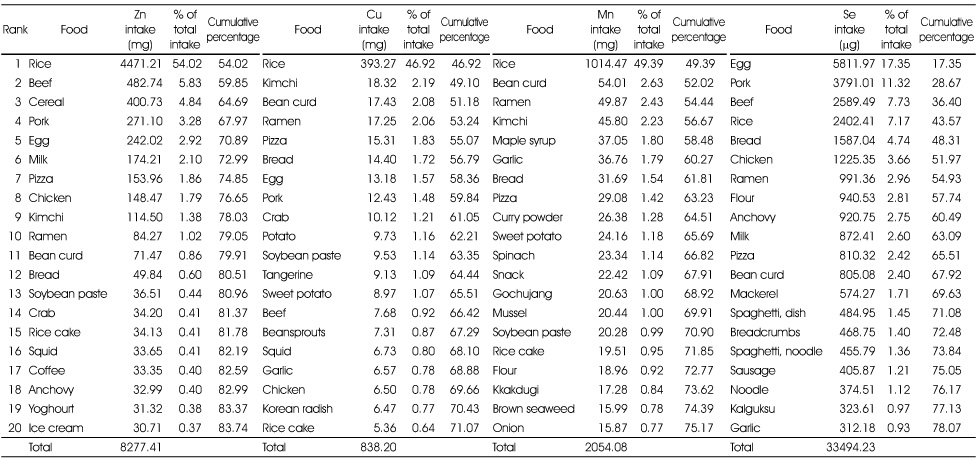References
1. Caulfield LE, Black RE. In : Ezzati M, Lopez AD, Murray CJ, Rodgers A, eds. Zinc deficiency. Comparative quantification of health risks: global and regional burden of diseases attributable to selected major risks 2004. Geneva: World Health Organization; 257.
2. Choi MK, Kang MH, Kim MH. The analysis of copper, selenium, and molybdenum contents in frequently consumed foods and an estimation of their daily intake in Korean adults. Biol Trace Elem Res 2009a. 128(2)104–117.
3. Choi MK, Kim EY. Evaluation of dietary manganese intake in Korean men and women over 20 years old. J Korean Soc Food Sci Nutr 2007. 36(4)447–452.
4. Choi MK, Kim HS, Lee WY, Lee HM, Ze KZ, Park JD. Comparative evaluation of dietary intakes of calcium, phosphorus, iron, and zinc in rural, coastal, and urban district. J Korean Soc Food Sci Nutr 2005. 34(5)659–666.
5. Choi YJ, Kim JY, Lee HS, Kim CI, Hwang IK, Park HK, Oh CH. Selenium content in representative Korean foods. J Food Compost Anal 2009b. 22(2)117–122.
6. Duffield-Lillico AJ, Dalkin BL, Reid ME, Turnbull BW, Slate EH, Jacobs ET, Marshall JR, Clark LC. Nutritional Prevention of Cancer Study Group. Selenium supplementation, baseline plasma selenium status and incidence of prostate cancer: an analysis of the complete treatment period of the Nutritional Prevention of Cancer Trial. BJU Int 2003. 91(7)608–612.
7. Galhardi CM, Diniz YS, Faine LA, Rodrigues HG, Burneiko RC, Ribas BO, Novelli EL. Toxicity of copper intake: lipid profile, oxidative stress and susceptibility to renal dysfunction. Food Chem Toxicol 2004. 42(12)2053–2060.
8. Ge K, Xue A, Bai J, Wang S. Keshan disease-an endemic cardiomyopathy in China. Virchows Arch A Pathol Anat Histopathol 1983. 4011–15.
9. Greger JL. Dietary standards for manganese: overlap between nutritional and toxicological studies. J Nutr 1998. 1282 Suppl. 368S–371S.
10. Gwag EH, Lee SL, Yun JS, Lee HS, Kwon JS, Kwon IS. Macronutrient, mineral and vitamin intakes in elderly people in rural area of North Kyungpook province in South Korea. Korean J Nutr 2003. 36(10)1052–1060.
11. Hambidge M. Human zinc deficiency. J Nutr 2000. 130(5S)1344S–1349S.
12. Jablonska E, Gromadzinska J, Sobala W, Reszka E, Wasowicz W. Lung cancer risk associated with selenium status is modified in smoking individuals by Sep15 polymorphism. Eur J Nutr 2008. 47(1)47–54.
13. Kim CH, Paik HY, Joung HJ. Evaluation of zinc and copper status in Korean college women. Korean J Nutr 1999. 32(3)277–286.
14. Kim SH. Dietary copper intakes and nutritional status of copper in serum among elementary schoolchildren in Chungnam province in Korea: comparison between remote rural and urban areas. Korean J Nutr 2006. 39(4)381–391.
15. Kim KH, Lim HS. Dietary intakes, serum concentrations, and urinary excretions of Fe, Zn, Cu, Mn, Se, Mo, and Cr of Korean young adult women. Korean J Nutr 2006. 39(8)762–772.
16. Lee JY, Choi MK, Sung CJ. The relationship between dietary intakes, serum levels, urinary excretions of Zn, Cu, Fe and serum lipids in Korean rural adults on self - selected diet. Korean J Nutr 1996. 29(10)1112–1120.
17. Linder MC, Hazegh-Azam M. Copper biochemistry and molecular biology. Am J Clin Nutr 1996. 63(5)797S–811S.
18. MacDonald RS. The role of zinc in growth and cell proliferation. J Nutr 2000. 130(5S)1500S–1508S.
19. Medeiros DM, Bagby D, Ovecka G, McCormick R. Myofibrillar, mitochondrial and valvular morphological alterations in cardiac hypertrophy among copper-deficient rats. J Nutr 1991. 121(6)815–824.
20. Mena I. In : Bronner FL, Coburn JW, eds. Disorders of mineral metabolism 1981. New York: Academic Press; 230–270.
21. Ministry of Health, Welfare and Family Affairs [MOHWFA]. Korea Center for Disease Control and Prevention [KCDCP]. 2007 National Health Statistics- The 4th Korea National Health and Nutrition Examination Survey, the first year (2007) 2008. Korea: Korea Center for Disease Control and Prevention;
22. Ministry of Health, Welfare and Family Affairs [MOHWFA]. Korea Center for Disease Control and Prevention [KCDCP]. 2008 National Health Statistics- The 4th Korea National Health and Nutrition Examination Survey, the second year (2008) 2009. Korea: Korea Center for Disease Control and Prevention;
23. Ministry of Health, Welfare and Family Affairs [MOHWFA]. Korea Center for Disease Control and Prevention [KCDCP]. 2009 National Health Statistics- The 4th Korea National Health and Nutrition Examination Survey, the third year 2010. Korea: Korea Center for Disease Control and Prevention;
25. Park JS, Chyun JH. Ditary zinc analysis and changes of zinc nutriture with zinc supplementation in Korean adults. Korean J Nutr 1993. 26(9)1110–1117.
26. Qin Y, Melse-Boonstra A, Shi Z, Pan X, Yuan B, Dai Y, Zhao J, Zimmermann MB, Kok FJ, Zhou M. Dietary intake of zinc in the population of Jiangsu province, China. Asia Pac J Clin Nutr 2009. 18(2)193–199.
27. Rayman MP. Selenium in cancer prevention: a review of the evidence and mechanism of action. Proc Nutr Soc 2005. 64(4)527–542.
28. Rural Resources Development Institute, Rural Development Administration. Food composition table 2006. Korea:
29. Sandström B, Davidsson L, Eriksson R, Alpsten M, Bogentoft C. Retention of selenium (75Se), Zinc (65Zn) and manganese (54Mn) in humans after intake of a labelled vitamin and mineral supplement. J Trace Elem Electrolytes Health Dis 1987. 1(1)33–38.
30. Sohng KY, Park CS. Eating habits, trend of disordered eating, weight reduction practice and body size evaluation of college students in Seoul. Korean J Women Health Nurs 2003. 9(4)457–466.
31. Solomons NW. Biochemical, metabolic, and clinical role of copper in human nutrition. J Am Coll Nutr 1985. 4(1)83–105.
32. Son SM, Sung SL. Zinc and copper intake with food analysis and levels of zinc and copper in serum, hair and urine of female college students. Korean J Nutr 1999. 32(6)705–712.
33. Sung CJ. The dietary, blood and urinary levels of lead, iron and copper in self selected dietary rural people. J Korean Soc Food Nutr 1993. 22(6)716–723.
34. Sung CJ, Yoon YH. The study of Zn, Cu, Mn, Ni contents of serum, hair, nail and urine for female college students. Korean J Food Nutr 2000. 29(1)99–105.
35. The Korean Nutrition Society [KNS]. Dietary reference intakes for Koreans 2010. Seoul: 2–7.
442–444.
36. USDA National nutrient database for standard reference, Release 23. Nutrient Data Laboratory Home Page. U.S. Department of Agriculture, Agricultural Research Service 2010. cited 2011 October 14. Available from
http://www.ars.usda.gov/nutrientdata.
37. Willet W. Nutritional Epidemiology 1990. New York: Oxford University Press; 20–34.
38. Yang HR. Study of the dietary selenium intake and selenium status of Korean women 2003. Dankook University; Ph. D.
39. Yeon JY, Sung CJ. A study on dietary mineral intakes, urinary mineral excretions, and bone mineral density in Korean postmenopausal women. Korean J Community Nutr 2011. 16(5)569–579.
40. Yoneyama S, Miura K, Itai K, Yoshita K, Nakagawa H, Shimmura T, Okayama A, Sakata K, Saitoh S, Ueshima H, Elliott P, Stamler J. INTERMAP Research Group. Dietary intake and urinary excretion of selenium in the Japanese adult population: the INTERMAP Study Japan. Eur J Clin Nutr 2008. 62(10)1187–1193.





